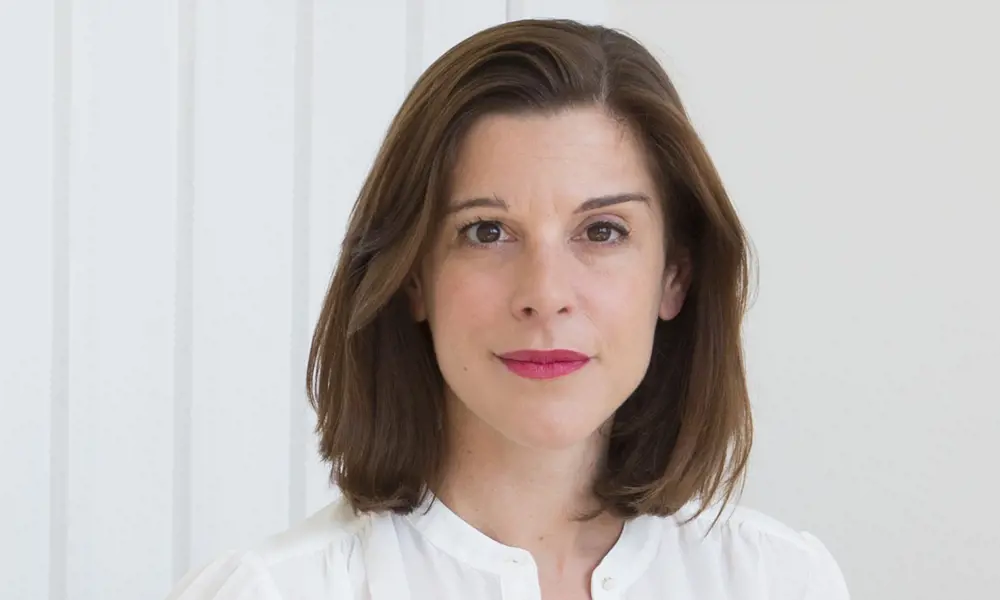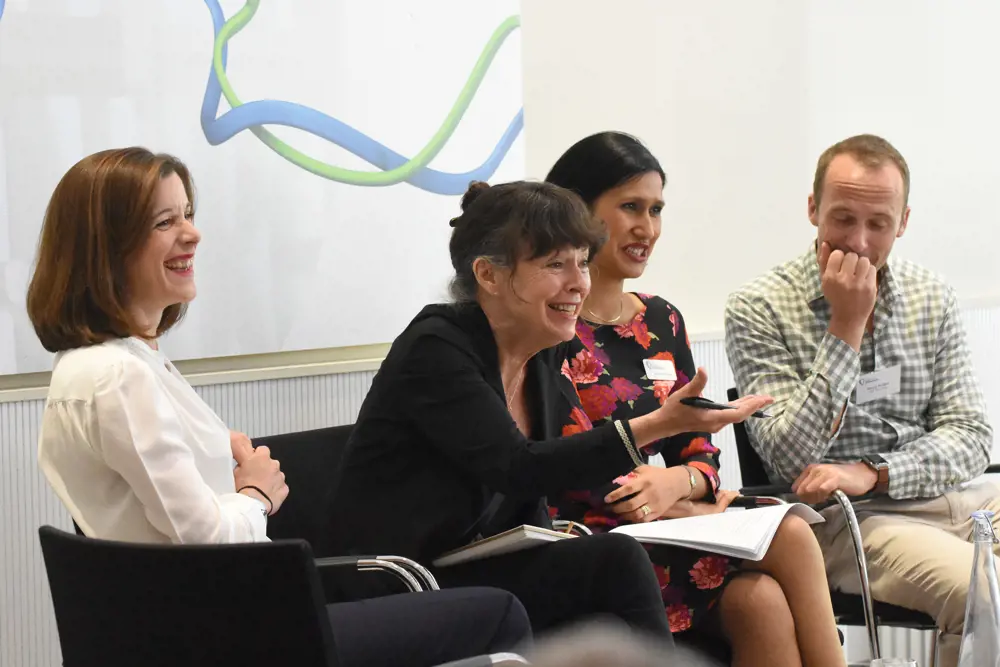
The entrepreneur solving engineering problems with data
A common view of engineers is that they build things. Elspeth Finch MBE FREng likes to say instead that her engineering career is about removing friction. Her targets could be the barriers that hindered pedestrians in London’s busiest traffic junctions, but more recently she’s had barriers to scaling innovation in her sights.
In her career, Finch’s focus on user experience (UX) and driving impact has moved from devising ways to create better transport systems towards developing tools and techniques that take a data-driven approach to build enterprise software for engineering companies.
When she was younger and picking career options, science was an obvious candidate: her mother was a medical physicist and her father was a physics professor. There was even an engineer in the family: her grandfather had started out as an apprentice and became a railways engineer. While she originally planned a career in chemistry, Finch soon moved to the applied side of science that had always appealed to her.
Before heading to university, college students in Scotland study more subjects for their ‘Highers’ than their counterparts in England. Finch took advantage of this to broaden her education studying music and art alongside sciences, an interest that continues in her love of art and design to this day. “Part of the engineering that I do is trying to understand the interplay between design and users.”
A common view of engineers is that they build things. Elspeth Finch MBE FREng likes to say instead that her engineering career is about removing friction.
She also took her first steps along the entrepreneurial road. On discovering that her school planned to produce its first yearbook for graduating students, Finch put herself forward to be editor. “It was a good opportunity, at the age of 16/17, to work out how to build a team, how to go out and get advertising. It was a really safe way to do entrepreneurship in a mini space. I realised that I was quite good at being able to pull a team together. And I really enjoyed it.”

Intelligent Space Partnership was part of the team that addressed the intersection between Oxford Street and Regent Street in London’s Oxford Circus area, one of the country’s busiest stretches of pavement © Shutterstock
Data and the Oxford Circus diagonal crossing
📊 Transforming London's iconic junction
The importance of using data wisely
Finch realised the value and importance of data when she moved to the engineering department at Newcastle University for her master’s in transport policy with her thesis on the impacts of electric vehicles on cities. She sees data and how to use it as being a big part of her career. “I think data is really interesting, but the hardest thing with data is knowing what questions to ask of it.” We’re hugely data rich, she adds. Then there are the unknowns. “What’s really interesting is not only what data exists, but what are the gaps?”
This goes back to Finch’s early work on cities. When she was a part of the team that set out to change Oxford Circus, there was a large data gap. “There was great data on vehicles, but very, very weak data on pedestrians.” It’s hard to predict what pedestrians will do.
City planning to save pedestrians time
Previously, planning for Oxford Street had revolved around saving time for vehicles. But, as Finch points out, with as many as 40,000 people walking through the area every hour “that’s not where the money is”. At the time, shopping in London’s West End accounted for sales of £9 billion each year. But with no data on the value of pedestrians’ time, it was hard to make a business case for development plans.
First, the team gathered data on how people behaved. Camera footage of the area provided the basis for a model that could pinpoint bottlenecks. The architects and engineers used this to redesign the intersection, adding a diagonal crossing to smooth the flow of traffic and pedestrians.
Finch sees a common thread in her career as being the ability to take what people may see as soft measures, such as the number of pedestrians crossing the road, and to turn them into hard metrics, to provide something that can be used as the basis for good decisions. “When we looked at Oxford Circus, the entire business case was based on the time savings for pedestrians.”
IAND: a different kind of data mining
At IAND – her new company – data mining is very different. As well as making money, a modern business must meet a raft of non-financial targets, on climate performance and workforce diversity, for example. There are also policies designed to improve innovation and productivity through such measures as the promotion of net zero in the workplace. Therefore companies have board-level committees that handle governance issues such as safety, ethics and sustainability.
IAND’s cloud-based platform captures public and confidential data on these and other characteristics. On top of financial reports larger companies must file information on employment practices, including Gender Pay Gap data. The platform uses this data along with, for example, location details of the SMEs that can be part of the wider supply chain. This also sits alongside data on government-funded R&D programmes in businesses of all sizes. Innovate UK, for example, distributes R&D grants to businesses throughout the country. IAND’s software can turn these official spreadsheets, with some 40,000 lines of data, into useful information. “We automatically pull in the funding that people have had from Innovate UK,” Finch explains. If you can see where the R&D happens, you see where you can work with suppliers to scale up innovation.
Data offers businesses ways to study their performance but trying to wade through everything manually would deter anyone. Finch feels that another thread that pervades her career is the ability to combine a passion for data with understanding the user experience and what people want to do. The company’s software engineers have built a data platform that draws on experience from retail e-commerce operations and designed its own interface. “If you want a platform that will save people time, you want it to be intuitive and easy to use.”
Changing lanes from science to engineering
With Highers done and dusted, at just 17, Finch went to the University of York to study chemistry. She soon realised that she was more interested in the applied side of science. “I discovered that what I really liked was understanding how to solve problems that affected people directly.”
In 1996, a summer internship after she finished her degree gave her a further nudge. Finch worked as a research chemist for a small startup in London and Cambridge that was developing technology to monitor the heart’s flow rate. “I wasn’t a great research chemist,” she admits, but she was exposed to the inner workings of a startup. “The chief exec was really kind and took me under his wing. He gave me opportunities to look at business processes. He let me tag along to meetings with investors.” This furthered her appetite for entrepreneurship and secured Finch her first mentor.
Finch followed this summer job with a master’s degree in the engineering department at Newcastle University. Keen to study the impact of air pollution on health, she investigated the potential economic and health impacts of fuel cells and electric vehicles on cities. “That’s really how I ended up in engineering.” The next natural step was to take the master’s further, so she moved to The Bartlett Faculty of the Built Environment at UCL and started a PhD on the impact of pollution on people in cities.
At UCL Finch moved into data engineering when she realised that computer models created to support the design of new developments could be valuable for other purposes. The models could benefit not just architects working on buildings but also transport planners and developers. This realisation brought about the hard decision to start a company rather than finish her PhD.
In 2000, still just 24, Finch set up Intelligent Space Partnership, a consulting business that developed software for commercial use as a planning tool, bringing an evidence-based approach to modelling pedestrians in the built environment. She could see a market opportunity in using data to manage things that had previously been hard to pin down. “We built software and developed methodologies around how to better understand things like footfall on streets.” This meant putting pedestrians and cyclists into the heart of traffic planning.
Intelligent Space Partnership developed a growing reputation, working on projects in the US, Australia and Germany, leading to its acquisition by Atkins.

Finch (far left) joins a panel at an Innovators’ Network – the group that she set up to support Enterprise Hub members – diversity and inclusion event in 2017, alongside Academy CEO Dr Hayaatun Sillem CBE (second from right)
From entrepreneur to intrapraneur
Atkins, one of the UK’s largest engineering businesses, bought the company in 2007 and recruited Finch as a director. This gave her the opportunity to continue her focus on innovation, moving from entrepreneurship to intrapreneurship.
As Innovation Director for the European region, she could consider innovation on a bigger scale. “I could look at how we could build new businesses within Atkins. We created a network for innovators across the business.” The work moved on from bringing together 10,000 people in different parts of Atkins to enabling collaboration with other companies.
Finch is careful in her use of the ‘innovation’ word. It is the impact that matters, she insists. “Ideas are great, but that’s not innovation. For me, innovation is when you deliver impact. That might be the growth of a company, it might be transforming carbon reduction, it can be transforming social value, improving diversity in engineering.” Impact can also come from multiple sectors, she adds. “It doesn’t have to be financial, but you have to have measurable value.”
At Atkins, Finch started to become involved in the Royal Academy of Engineering and its work on innovation. In 2013 she received the Academy’s then Silver Medal, awarded for an outstanding personal contribution to UK engineering by an early- to mid-career engineer. The prize coincided with the Academy’s launch of the Enterprise Hub, which supports engineering entrepreneurs and SMEs to scale up and exploit their technologies. “It was serendipity,” she says. “I managed to get in almost at the ground floor. I’ve been with them on that journey.” The Hub was a natural blend of her own experience, first as the entrepreneurial brains behind a new and successful business and then as Atkins’s own promoter and enabler of internal entrepreneurship.
Invited to speak at Hub events and then to participate in various subcommittees, Finch came up with the idea of the Innovators’ Network to support the businesses backed by the Hub. “I could see that there was a bit of a gap. How do you bring together the people like me who were driving innovation in big business, and the entrepreneurs behind innovation in small businesses. The Innovators’ Network looked beyond the engineering community, enlisting people from the worlds of marketing and finance, for example.”
Finch was elected as an Academy Fellow in 2021 and joined the Academy’s Enterprise Committee, helping to guide the work of the Hub and the Academy’s enterprise activities. “I’m leading the work around creating a toolkit for startups and how they can be diverse and inclusive from start of a business.” With diversity high on the corporate agenda these days, and a topic that is important to Finch, businesses of all sizes need to pay attention to the issue, including startups. “It’s so much easier to be a diverse business if you start diverse. You can scale up, but it’s really hard to retrofit if you’re a big company.”
It’s so much easier to be a diverse business if you start diverse. You can scale up, but it’s really hard to retrofit if you’re a big company.
Elspeth Finch MBE FREng
Quick Q&A
Elspeth's engineering heroes, from the Pantheon to the Apple Pencil
What are you most proud of?
Negotiating 50:50 ownership in my first startup when I was 24 as it transformed my career.
Who influenced your engineering career?
Keith Clarke – when CEO of Atkins he not only bought my first company, but has shown belief in me ever since.
What’s your advice to budding engineers?
Communication is your superpower – learn how to present, to pitch, to write, to negotiate, to inspire.
Best part of the job now?
My team, my board, my clients. They are brilliant, supportive and I learn from them each day.
Which record/book would you take to a desert island?
Sketchbook (and pen please!).
Your most admired historical example of engineering?
The dome of the Pantheon in Rome – beautiful, ingenious and resilient. And despite being nearly 2,000 years old, remains the world’s largest unreinforced concrete dome.
Do you have a favourite gadget?
Apple Pencil: makes it fast to capture and share ideas.
Which engineering achievement couldn’t you do without?
The internet, as IAND is on the cloud!
A second startup and supporting engineering founders
Going back to her entrepreneurship roots, Finch has launched another new startup, IAND. She loved her eight years at Atkins, but as she says, “I knew that I had another company in me.” This time she has drawn on her time dealing with suppliers and customers at Atkins.
As she did with Intelligent Space Partnership, which leveraged data to ensure cities worked for everyone not just cars, in 2016 she set up IAND to tackle another hidden problem, the cost and friction of managing relationships with suppliers, and the data challenge of delivering on increasing environmental, social and corporate governance (ESG) goals.
Her personal experience taught Finch about managing supply chain relationships and also the need for software that supports collaboration and removes the admin burden from engineers and project teams. “I could see the problem from a range of different dimensions,” she explains. “I’d had the experience of being a supplier to a big company, working for clients and understanding the governance around how a big company works.”
Starting with a blank sheet of paper, Finch was able to rethink how enterprise software could work, creating a diverse team focused on building a great user experience not only for clients managing suppliers, but the suppliers too. The team has been recognised as industry leaders by CIPS (the Chartered Institute of Procurement and Supply Chain) through a recent award. The IAND software is also now used by organisations including Network Rail, Atkins and Mott MacDonald to manage their supplier relationships.
Not long ago that label of supplier relationship management would have meant little outside of practitioners. “It’s been a problem that’s been a bit hidden from view,” she explains. COVID-19 brought wider awareness, especially the scramble for personal protective equipment (PPE), which brought home how supply chains can be vulnerable.
With a focus on simplification, IAND tackled the data challenge of connecting the wealth of data that organisations amass in their own operations, along with public data available on suppliers, to give a full picture of suppliers in one place. The idea grew out of the realisation that today’s supply chains are evolving, and the need to have better visibility on suppliers, especially given the need to work with increasing numbers of SMEs.
While companies live and die on the health of their supply chains, government policy is also crucial, especially when it comes to procurement. The government spends about £300 billion a year on products and services, about a third of all public spending. Government procurement can play a key role in encouraging innovation and the growth of SMEs. So, this is another natural target for IAND. Finch brings to this her insights from her work as a member of the government’s Innovation Expert Group (IEG), in which she led a subgroup on procurement. “We were looking at how you can use procurement as a lever for innovation,” says Finch.
Career timeline and distinctions
Studied chemistry at the University of York, 1993–1996. Master’s in transport planning and policy, Newcastle University, 1996–1997. Founding partner, Intelligent Space Partnership, 2000–2007. Operations director, Atkins, 2007–2010. Futures Director, Water and Environment, Atkins, 2010–2014. Awarded RAEng Silver Medal, 2013. Innovation Director, UK and Europe, Atkins, 2014–2015. Appointed a Member of the Order of the British Empire, 2018. CEO, IAND, 2016 to present. Fellow, Royal Academy of Engineering, 2021.
Procurement also comes into the picture when businesses want to bid for government work. They must operate according to a series of regulations covering net zero and social value. These take in measures such as ‘prompt payment’ to their own suppliers along with net zero regulations that require suppliers to have a carbon reduction plan.
Companies don’t just have to adopt the regulations, they have to monitor their work and provide evidence that they are following the rules. This is where IAND can play a part. Companies aren’t alone in the need to monitor their activities. Governments also want to check the outcomes from their own actions. As Finch sees it, there is room for improvement in analysing policy implementation. “For me, understanding why some good policies are not delivering the value that they could deliver is an area where there’s huge opportunity for change. If I think about the things which really deliver value in scaling up innovation, it’s often things that are hugely unsexy. It’s procurement, it’s contracts. It’s understanding how you manage risk.”
It is a universal issue that faces any organisation. “How do we make sure that we really understand what the real blockers are for scaling up innovation within organisations? It is about really aligning goals. I think technology can play a huge part in this in terms of really understanding the root cause.”
So, what’s next? The focus for Finch now is all on scaling innovation. She is supporting the Scottish government in scaling up innovation in Scotland as a member of the Innovation Strategy Steering Group. At the Academy she is supporting other founders in scaling their businesses as a mentor in the Enterprise Hub and as part of the Enterprise Committee. Most importantly, Finch will be leading IAND on its own scale-up journey as it enters new markets, working with new customers to take IAND on the exciting next stage of its growth.
***
This article has been adapted from "Data-driven entrepreneur", which originally appeared in the print edition of Ingenia 94 (March 2023).
Contributors
Michael Kenward OBE
Author
Keep up-to-date with Ingenia for free
SubscribeRelated content
Software & computer science

Pushing the barriers to model complex processes
In 2007, Imperial College London spinout Process Systems Enterprise Ltd won the MacRobert Award for its gPROMS (general-purpose PROcess Modelling System) software. Costas Pantelides and Mark Matzopoulos, two of the key people behind the success of gPROMS, tell how they created a way in which engineers can harness physics, chemistry and engineering knowledge within a framework that solves highly complex mathematical problems.

Compact atomic clocks
Over the last five decades, the passage of time has been defined by room-sized atomic clocks that are now stable to one second in 100 million years. Experts from the Time and Frequency Group and the past president of the Institute of Physics describe a new generation of miniature atomic clocks that promise the next revolution in timekeeping.

The rise and rise of GPUs
The technology used to bring 3D video games to the personal computer and to the mobile phone is to take on more computing duties. How have UK companies such as ARM and ImaginationTechnologies contributed to the movement?

EU clarifies the European parameters of data protection
The European Union’s General Data Protection Regulation, due for adoption this year, is intended to harmonise data protection laws across the EU. What are the engineering implications and legal ramifications of the new regulatory regime?
Other content from Ingenia
Quick read

- Environment & sustainability
- Opinion
A young engineer’s perspective on the good, the bad and the ugly of COP27

- Environment & sustainability
- Issue 95
How do we pay for net zero technologies?
Quick read

- Transport
- Mechanical
- How I got here
Electrifying trains and STEMAZING outreach

- Civil & structural
- Environment & sustainability
- Issue 95